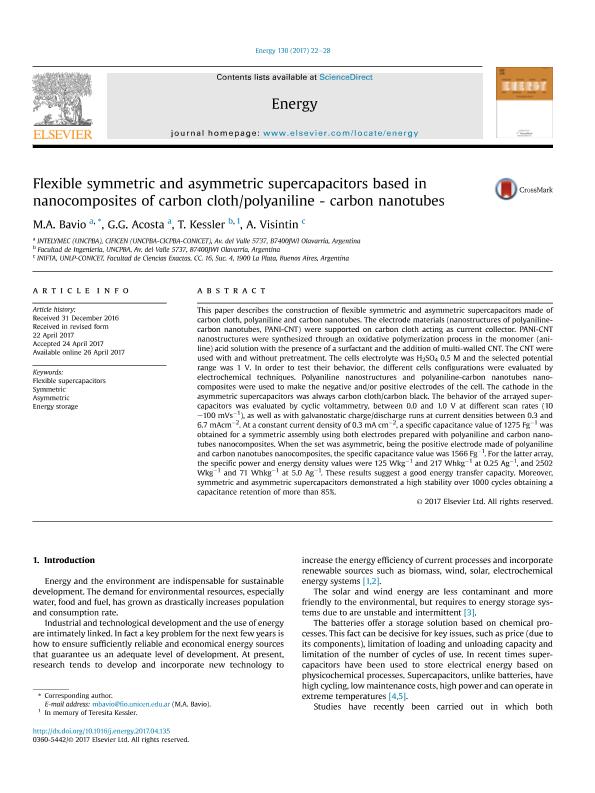Mostrar el registro sencillo del ítem
dc.contributor.author
Bavio, Marcela Alejandra

dc.contributor.author
Acosta, Gerardo Gabriel

dc.contributor.author
Kessler, Teresita

dc.contributor.author
Visintin, Arnaldo

dc.date.available
2018-09-04T22:41:09Z
dc.date.issued
2017-07
dc.identifier.citation
Bavio, Marcela Alejandra; Acosta, Gerardo Gabriel; Kessler, Teresita; Visintin, Arnaldo; Flexible symmetric and asymmetric supercapacitors based in nanocomposites of carbon cloth/polyaniline - carbon nanotubes; Pergamon-Elsevier Science Ltd; Energy; 130; 7-2017; 22-28
dc.identifier.issn
0360-5442
dc.identifier.uri
http://hdl.handle.net/11336/58341
dc.description.abstract
This paper describes the construction of flexible symmetric and asymmetric supercapacitors made of carbon cloth, polyaniline and carbon nanotubes. The electrode materials (nanostructures of polyaniline-carbon nanotubes, PANI-CNT) were supported on carbon cloth acting as current collector. PANI-CNT nanostructures were synthesized through an oxidative polymerization process in the monomer (aniline) acid solution with the presence of a surfactant and the addition of multi-walled CNT. The CNT were used with and without pretreatment. The cells electrolyte was H2SO4 0.5 M and the selected potential range was 1 V. In order to test their behavior, the different cells configurations were evaluated by electrochemical techniques. Polyaniline nanostructures and polyaniline-carbon nanotubes nanocomposites were used to make the negative and/or positive electrodes of the cell. The cathode in the asymmetric supercapacitors was always carbon cloth/carbon black. The behavior of the arrayed supercapacitors was evaluated by cyclic voltammetry, between 0.0 and 1.0 V at different scan rates (10–100 mVs−1), as well as with galvanostatic charge/discharge runs at current densities between 0.3 and 6.7 mAcm−2. At a constant current density of 0.3 mA cm−2, a specific capacitance value of 1275 Fg−1 was obtained for a symmetric assembly using both electrodes prepared with polyaniline and carbon nanotubes nanocomposites. When the set was asymmetric, being the positive electrode made of polyaniline and carbon nanotubes nanocomposites, the specific capacitance value was 1566 Fg−1. For the latter array, the specific power and energy density values were 125 Wkg−1 and 217 Whkg−1 at 0.25 Ag−1, and 2502 Wkg−1 and 71 Whkg−1 at 5.0 Ag−1. These results suggest a good energy transfer capacity. Moreover, symmetric and asymmetric supercapacitors demonstrated a high stability over 1000 cycles obtaining a capacitance retention of more than 85%.
dc.format
application/pdf
dc.language.iso
eng
dc.publisher
Pergamon-Elsevier Science Ltd

dc.rights
info:eu-repo/semantics/openAccess
dc.rights.uri
https://creativecommons.org/licenses/by-nc-sa/2.5/ar/
dc.subject
Asymmetric
dc.subject
Energy Storage
dc.subject
Flexible Supercapacitors
dc.subject
Symmetric
dc.subject.classification
Ingeniería de Sistemas y Comunicaciones

dc.subject.classification
Ingeniería Eléctrica, Ingeniería Electrónica e Ingeniería de la Información

dc.subject.classification
INGENIERÍAS Y TECNOLOGÍAS

dc.subject.classification
Recubrimientos y Películas

dc.subject.classification
Ingeniería de los Materiales

dc.subject.classification
INGENIERÍAS Y TECNOLOGÍAS

dc.title
Flexible symmetric and asymmetric supercapacitors based in nanocomposites of carbon cloth/polyaniline - carbon nanotubes
dc.type
info:eu-repo/semantics/article
dc.type
info:ar-repo/semantics/artículo
dc.type
info:eu-repo/semantics/publishedVersion
dc.date.updated
2018-09-03T19:59:54Z
dc.journal.volume
130
dc.journal.pagination
22-28
dc.journal.pais
Estados Unidos

dc.journal.ciudad
Nueva York
dc.description.fil
Fil: Bavio, Marcela Alejandra. Universidad Nacional del Centro de la Provincia de Buenos Aires. Centro de Investigaciones en Física e Ingeniería del Centro de la Provincia de Buenos Aires. - Consejo Nacional de Investigaciones Científicas y Técnicas. Centro Científico Tecnológico Conicet - Tandil. Centro de Investigaciones en Física e Ingeniería del Centro de la Provincia de Buenos Aires. - Provincia de Buenos Aires. Gobernación. Comisión de Investigaciones Científicas. Centro de Investigaciones en Física e Ingeniería del Centro de la Provincia de Buenos Aires; Argentina
dc.description.fil
Fil: Acosta, Gerardo Gabriel. Universidad Nacional del Centro de la Provincia de Buenos Aires. Centro de Investigaciones en Física e Ingeniería del Centro de la Provincia de Buenos Aires. - Consejo Nacional de Investigaciones Científicas y Técnicas. Centro Científico Tecnológico Conicet - Tandil. Centro de Investigaciones en Física e Ingeniería del Centro de la Provincia de Buenos Aires. - Provincia de Buenos Aires. Gobernación. Comisión de Investigaciones Científicas. Centro de Investigaciones en Física e Ingeniería del Centro de la Provincia de Buenos Aires; Argentina. Universidad Nacional del Centro de la Provincia de Buenos Aires. Facultad de Ingeniería Olavarría. Departamento de Electromecánica. Grupo INTELYMEC; Argentina
dc.description.fil
Fil: Kessler, Teresita. Universidad Nacional del Centro de la Provincia de Buenos Aires. Facultad de Ingeniería Olavarría; Argentina
dc.description.fil
Fil: Visintin, Arnaldo. Consejo Nacional de Investigaciones Científicas y Técnicas. Centro Científico Tecnológico Conicet - La Plata. Instituto de Investigaciones Fisicoquímicas Teóricas y Aplicadas. Universidad Nacional de La Plata. Facultad de Ciencias Exactas. Instituto de Investigaciones Fisicoquímicas Teóricas y Aplicadas; Argentina
dc.journal.title
Energy

dc.relation.alternativeid
info:eu-repo/semantics/altIdentifier/url/https://www.sciencedirect.com/science/article/pii/S0360544217307028
dc.relation.alternativeid
info:eu-repo/semantics/altIdentifier/doi/http://dx.doi.org/10.1016/j.energy.2017.04.135
Archivos asociados
